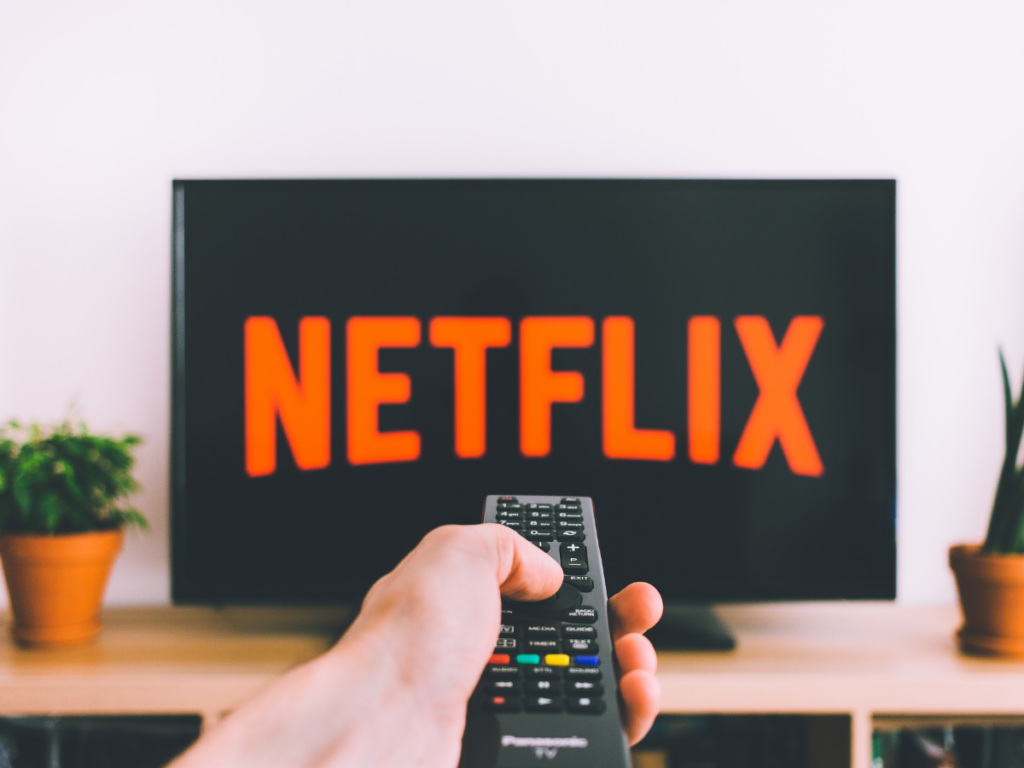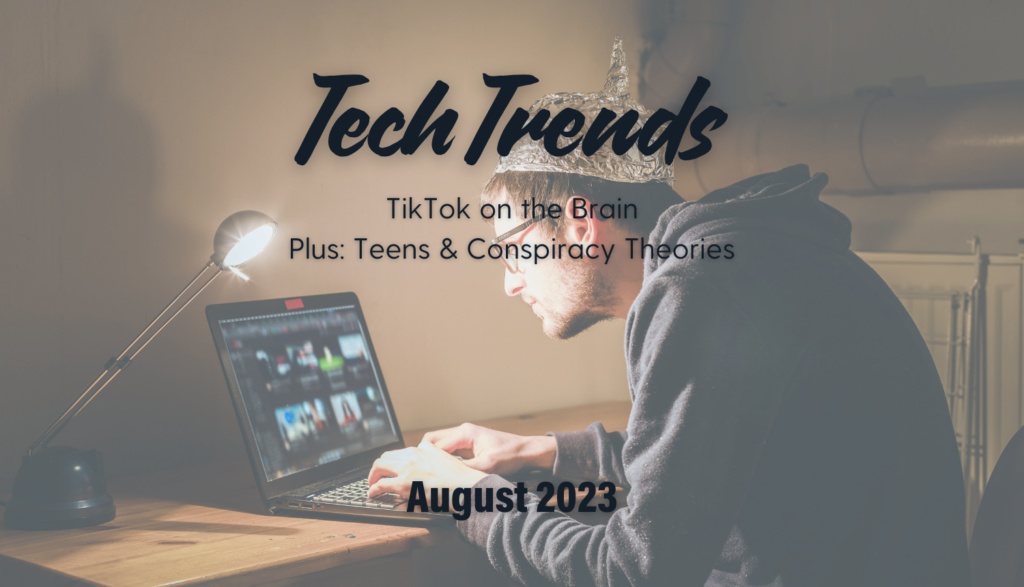Each month, our Tech Trends blog unpacks how technology is shaping, influencing and changing us today—and especially how it’s impacting kids. And it will also give you the scoop on those things called “hashtags,” so you can stay up to date on all the things your kids might be obsessed with.
And ICYMI (“in case you missed it,” for those up on their social acronyms), you can check out July’s Tech Trends, too.
Let’s dive in.

TikTok on—and in—the Brain
Elon Musk seems like he’s in the news almost all the time. But you might have missed this little story–on Twitter, er, X, of course. On the platform formerly known as Twitter, a graphic designer at Dogecoin tweeted (or x’ed? It just doesn’t work quite as well, does it?), “TikTok is destroying civilization.” Mr. Musk responded with an, er, um, x of his own: “I tried using TikTok and felt their AI probing my brain, so I stopped.”
I’ll walk past the temptation to comment on how Twitter’s algorithms likely work similarly, and say simply that research continues to uncover new ways that TikTok is, it seems, very much at work on our brains. Scientists are fascinated by the recent popularity of bottle-smashing videos there, and they speculate that the sound of smashed glass has a strangely therapeutic effect on some folks’ brains.
Meanwhile, still more research suggests that TikTok is, in fact, obliterating our collective attention span. The Week summarized new research addressing the question, “What happens to our brains when we get hooked on short-form videos?” No surprise here: It ain’t good. Addictive behavior and an inability to engage in “directed attention” activities, such as reading, are among the outcomes of too much exposure to this medium.
Writing earlier this year, The Oxford Blue’s contributor Jui Zaveri notes:
“Personally, I don’t think I could sit through a whole film anymore. Why would I want to? An Instagram Reel could give me the same hit of emotion in a much shorter timeframe—it is literally designed to be the perfect quick fix. The people around me are the same: lectures on double speed, YouTube videos watched with one finger tensed over the button that skips 5 seconds ahead, impatience with any media longer than a few minutes at most. In fact, nearly 50% of users surveyed by TikTok said that videos longer than a minute long were ‘stressful.’ The truth is that our attention spans are shrinking.”

Who Could Possibly Believe That? Well, Teens.
“Dad, you’re never gonna believe this story I saw on Instagram!” your teen breathlessly tells you. And, he’s right: You don’t. That’s because it’s obviously a conspiracy theory. So if you’ve ever wondered if your child is particularly naïve in this area, take comfort: New research suggests that teens are more prone to believe online conspiracy theories than previous generations.
The Center for Countering Digital Hate, which focuses on identifying misinformation (more on that in a moment), recently reported that 60% of 13- to 17-year-olds agreed with four or more harmful conspiracy theory statements often found on social media, compared to 49% for adults. And the percentage rose, to 69%, for teens who spent four or more hours a day on a single social media outlet.
“There’s a prejudice towards believing that youth will save us from the ills created by the former generations, but when it comes to misinformation, there are no future generations to save us from the damage that we’ve caused,” said CCDH CEO Imran Ahmed. He also believes that failure to help children discern what constitutes misinformation could undermine “our democracy and the values that underpin it,” which he says are “under an almost impossible strain.”
Perhaps ironically, however, some government officials have also questioned the CCDH’s understandings of what constitutes misinformation and whether or not eliminating it online could constitute censorship and a threat to the First Amendment. (Also, Elon Musk’s X is suing CCDH, alleging that the company’s research has damaged the social media platform’s traffic.)
Still, if we want to help our kids grow in media and news discernment as they encounter potentially questionable stories online, some simple questions can teach them to ask and then regularly engage in conversations using those questions:
- What is the source of this story?
- Does the basic premise of the story seem likely to be true?
- Can you sense any bias in the reporting skewing toward a particular interpretation?
- How could you verify whether the claims in this story are true?
Just teaching our kids to ask some basic questions like these—and then modeling those questions for them—can go a long way to helping them grow in news media discernment.

Which Brand Do (British) Kids Think is Coolest? It’s Netflix.
If you’ve been lying awake at night wondering feverishly what the kids are into these days, well, you can look forward to a full night’s sleep tonight. Because Beano Brain, self-described as a “specialist kids and family insights agency,” has just released its annual answer to that question. Well, in the UK, at least, where it surveyed 60,000 kids between the ages of 7 and 14. It’s a curious mixture of technology, junk food and, um, footwear. Here are the top 10:
- Netflix
- YouTube
- McDonald’s
- Nike
- Oreo
- Nintendo
- Pringles
- Disney
- Roblox
- Coca-Cola
Looking at a list like this, it’s no surprise that the World Economic Forum prognosticates that half the world’s population will be overweight by 2035.

#HashtagTrending
Hashtags, trends, reels, sounds, tracks, stories—we know it feels impossible to keep up with what the kids are into these days. But here’s a quick overview of what your teen might be posting/watching on TikTok, Instagram and all the other “socials” this month. (Compiled by Emily Tsiao)
- “Dance The Night” (883K posts) – There are a couple of Barbie-themed trends this month, starting with this one featuring Dua Lipa’s “Dance the Night” from, you guessed it, the Barbie movie’s soundtrack.
- “Girrl” (393K posts) – This one isn’t so terrible. Essentially, influencers are using the “GIRRL” audio by Raymon Marco to showcase all the footage they haven’t had a chance to use yet.
- “Super Shy” (258K posts) – I’m not entirely sure what New Jeans’ “Super Shy” has to do with nail art or morning vlogs, but that’s the trend.
- “Love Like This” (181K posts) – Creators are pairing “Love Like This,” an audio clip from Austin Millz, to recap their weekends. Because, you know, why tell people in person when you can show them online?
- “Barbie World” (174.3K posts) – Told ya’ there’d be more Barbie. This TikTok trend isn’t really surprising. Folks are basically showing off anything and everything pink. But parents should be aware of some serious issues with the song itself by Nicki Minaj and Ice Spice.
- “Cruel Summer” (160.3K posts) – With the extension of Taylor Swift’s Eras tour, you may be hearing this sped up version of her song on top of everything from recipe how-tos to travel vlogs.
- “Vampire” (152.6K posts) – In yet another weird TikTok trend, users are pairing this popular (and somewhat problematic) track by Olivia Rodrigo with videos that have almost nothing to do with the song.
- “Yachts” (100K posts) – Folks like to showcase their daily routines, exotic travels and creative projects. And that’s what this trend is all about.
- “Summer Rain” (90.6K posts) – Man, you’d think people would get tired of showcasing their lives on TikTok and Instagram. But If there’s a “chill vibes” track out there, you can bet it’ll start trending soon thereafter for just this purpose.
- “Sick & Twisted” (14.7K posts) – What’s a situation that’s “sick and twisted?” Well, this trend that drops an f-bomb for one.








3 Responses
-The best gift for parents to give their children is the foundation for a strong relationship with Jesus Christ. He is the one who can best help us discern His truth from the lies of the devil.
-“some government officials have also questioned the CCDH’s understandings of what constitutes misinformation and whether or not eliminating it online could constitute censorship and a threat to the First Amendment.”
The Internet doesn’t belong to any nation, let alone the US government, and private forums don’t owe hate speech a platform or an audience; otherwise, one could argue that even moderating the comments on Plugged In—which I think the site generally does a great job of—would itself be ‘censorship.’ Even Truth Social has rules on how to report “hateful conduct.”
I find it bizarre that so many Christians are so concerned about ‘free speech’ when the Word given to us tells us not that we can say what we want, when we want, but that “everyone will have to give account on the day of judgment for every empty word they have spoken” (Matthew 12:36, New International Version, excerpt), which I find sobering in light not only of the things so many of our politicians say, but also of the awful things too many pastors and teachers say from the pulpit.
-The opposite attention span effect can happen in a way. When TV went digital instead of analog, my family waited half a year, hoping the price of digital antennas would decrease. During that time, I only watched movies. When we got broadcast TV back, I found commercials to be very disjointed.